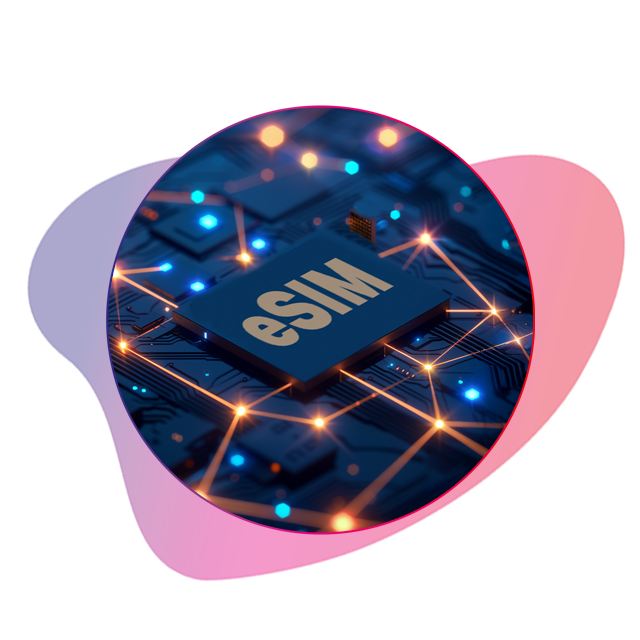In the dynamic world of the Internet of Things (IoT), reliable and flexible IoT connectivity is critical. The increasing networking of IoT devices in industries such as industry, logistics and medical technology requires powerful solutions. Traditional SIM cards are often tied to a single network operator and the network operator cannot be changed without physically replacing the SIM card.
This is where FUSION IoT’s Independent IoT eSIM steps in (currently in an advanced development phase and will be fully available within the course of this year). Developed in accordance with the SGP32 standard, this is an eSIM IoT solution that is independent of the network operator. This means you can change your network operator without replacing the SIM card, the ideal solution for IoT and M2M applications.
1. What is an eSIM?
2. SGP.32 – The new standard for eSIM management
3. FUSION IoT’s Independent IoT eSIM
3.1 Network operator independence
3.2 The benefits of Independent IoT eSIM
3.2.1 Continuously stable network infrastructure
3.2.2 Internet breakouts for maximum performance
3.2.3 Flexible management and integration
3.2.4 Security aspects of the Independent IoT eSIM
3.2.5 Future-proof deployment options
4. Conclusion
1. What is an eSIM?
An eSIM is a permanently installed or soldered-in SIM card chip that is capable of connecting to multiple mobile phone networks using its software. This eliminates the need to physically change a SIM card and allows remote management.
This is a key advantage, especially for IoT devices, which are often installed in hard-to-reach locations or distributed around the world where replacing classic physical SIM cards would be expensive both in time and cost.
But not every eSIM for IoT offers this connectivity flexibility – traditional IoT eSIMs are usually tied to a specific network operator.

Embedded SIM vs. eSIM vs. eUICC vs. Independent IoT eSIM – What are the differences?
Embedded SIM (SIM as hardware)
An embedded SIM refers to a permanently installed or soldered-in SIM card in a device. By default, it includes a single mobile profile that cannot be changed – similar to a replaceable physical SIM card, but in a non-removable format.
eSIM (software-programmable SIM)
An eSIM, on the other hand, can be either a permanently installed or a replaceable physical SIM (e.g. as a plastic SIM). The difference to the classic embedded SIM is that it is possible to manage mobile phone profiles remotely with an eSIM. However, this requires an eUICC-enabled SIM and appropriate management systems.
eUICC (Embedded Universal Integrated Circuit Card)
eUICC is a GSMA (Global System for Mobile Association) standard that allows you to store, manage, and switch multiple mobile phone profiles on a single SIM.
An eUICC-enabled SIM can store multiple profiles and switch them over-the-air (OTA). The switch is made via Remote SIM Provisioning (RSP) platforms that work with network operators.
However, not all eSIMs are eUICC-enabled – many IoT eSIMs remain tied to a single network operator.
Independent eSIM: The most flexible solution
FUSION IoT’s Independent IoT eSIM (currently in an advanced development phase and will be fully available within the course of this year) is an eUICC-enabled solution with true network independence:
- Dynamic switching between leading network operators, depending on availability, cost or performance.
- Automatic network selection optimized for M2M and IoT applications.
- Available as embedded eUICC enabled eSIM or classic physical SIM (e.g. triple SIM format for maximum compatibility).
This solution goes beyond traditional eSIM and eUICC eSIM by providing full control over mobile profiles, independent of one single network provider.

2. SGP.32 – The new standard for eSIM management
The GSMA released its first specifications for Remote SIM Provisioning (RSP) for M2M eSIM applications in 2013. This enabled remote management of SIM cards in use in M2M applications. The new GSMA SGP.32 standard (May 2023) significantly improves eSIM management for M2M and IoT devices.
Older standards such as SGP.22 (consumer devices) or SGP.02 required complex processes to change an eSIM profile. The SGP.32 makes it easy to load, activate, and manage IoT eSIM profiles for IoT devices in use.
Benefits of SGP.32 for IoT eSIMs:
✔ Remote deployment: Easy management of IoT eSIM profiles Over-the-Air (OTA)
✔ Increased security: Robust security protocols for secure data transfer
✔ Scalable: Flexible expansion and adaptation to IoT and M2M projects according to requirements
Specific parameters fixed when introducing an IoT solution can also be modified in the event of later scaling or other changes. This makes it possible to switch between network operators, tariffs and locations, to reduce costs and administrative overheads.
3. FUSION IoT’s Independent IoT eSIM
3.1 Network operator independence
When selecting an eSIM provider and the IoT connectivity platform, it is important to know what effects future changes in the general business conditions, and thus the process for potential switching, will have. Network operators themselves normally have no interest in designing and enabling an easy switching process which means customers find it difficult to change from their existing provider.
Many traditional IoT eSIM solutions are tied to specific network providers. FUSION IoT‘s Independent IoT eSIM, on the other hand, allows access to multiple network operators by default without additional connection costs. With its own Internet breakouts and infrastructure, it can flexibly control and manage traffic, so that a standardized network structure is also used during profile changes.
This creates a unique freedom for companies to design their IoT strategy independent of the specifications of individual network operators.
3.2 The benefits of Independent IoT eSIM
Independence & cost efficiency
Eliminate the need for network operator specific eSIM solutions and avoid additional connection costs.
Continuously stable network infrastructure
The network infrastructure, VPNs, IPs, and Internet breakouts are not affected by a profile change and remain stable.
User internet breakouts reduce latency and optimize data transfer for flexible, location-based connectivity.
Flexible management & seamless integration
Dynamic management of eSIM profiles and networks, directly integrated into enterprise systems thanks to GUI and API.
End-to-end encryption and GSMA compliant standards.
Scalability & future proofing
Easy integration of new devices with the latest standards without additional work and expenditure.
3.2.1 Continuously stable network infrastructure
Thanks to the unique architecture of the Independent IoT eSIM, the network configuration remains unchanged when switching profiles. While traditional eSIM solutions assign new IP addresses and break VPN tunnels when switching network operators, FUSION IoT’s approach ensures a continuously stable VPN connection with consistent IP addressing and identical internet breakout.
As a result, organizations retain full control over their IoT and M2M fleets without having to modify firewall rules or network routing. This allows for efficient, centrally controlled remote access while maintaining maximum flexibility in network selection.
3.2.2 Internet breakouts for maximum performance
FUSION IoT’s Independent eSIM uses its own direct Internet breakouts to reduce latency and optimize data transfer. In addition to Germany and Great Britain, thanks to our parent company, the Gamma Group, we can also offer this service in the Netherlands, Spain and Hungary. And other countries can also be included when required.
Flexible choice of internet breakout
Individual identification of preferred Internet breakout locations for each SIM for short response times, low latency and optimal end device performance
Network stability
The selected internet breakout applies to all profiles of the IoT and M2M eSIM, so that no change of network structure is required when changing the eSIM profile
A consistent VPN connection
Uniform VPN connectivity across network operators with fixed IP addresses, enabling consistent network configurations and simplified remote maintenance.
3.2.3 Flexible management and integration
The eSIM resource management platform is based on a highly scalable, cloud-based infrastructure that is fully integrated with FUSION IoT’s easy-to-use myFUSION SIM management platform. It supports both centralized and distributed network architectures and ensures that all eSIM processes are efficient and secure. This means:
- Centrally managed SIM and eSIM profiles in a single platform
- Transparent control of all connected devices
- Intuitive GUI & API integration for easy automation
The automatic control of the profile change can also be controlled flexibly by means of individual rule tables. This is possible for:
- Region, e.g. preferred network in certain countries for better coverage
- Technology, e.g. 2G, 5G or NB-IoT, LTE-M or 5G RedCap for cost or performance optimization
- Data consumption, e.g. switching the tariff if data consumption increases to reduce operating costs
This ensures optimal availability and efficiency of IoT applications. Businesses benefit from optimized operating costs and automated IoT connectivity.
3.2.4 Security aspects of the Independent IoT eSIM
IoT security is a key issue, especially when it comes to the transmission of sensitive data. FUSION IoT’s Independent IoT eSIM relies on state-of-the-art, multi-layered security mechanisms:
🔁End-to-end encryption
Safeguarding data integrity from source to target
🔐Extensive security mechanisms and authentications
Protection against unauthorized access through a robust security system
✅Compliance with GSMA security standards
Adherence to international security directives for IoT communications
These measures provide companies with the confidence that their data is optimally protected even in sensitive applications such as healthcare or financial services.
3.2.5 Future-proof deployment options
The Independent IoT eSIM can be supplied as an
- Embedded eSIM profile for modern IoT eSIM devices and as a
- classic physical eSIM in SIM chip and triple SIM format.
The physical eSIM deployment capability of the Independent IoT eSIM significantly expands the market by going beyond the IoT standard. Older M2M eSIM devices can also be integrated into an IoT eSIM infrastructure without hardware upgrades. Existing infrastructures can be future-proof without major hardware upgrades.
4. Conclusion
FUSION IoT‘s Independent IoT eSIM gives businesses a scalable, secure, and flexible IoT connectivity solution. With network operator independence, innovative security architecture and dynamic management, it is the ideal choice for future-proof IoT and M2M projects. IoT eSIM is currently in an advanced development phase and will be fully available within the course of this year.
Leverage your full IoT potential with reliable connectivity and customised solutions from FUSION IoT.
AUTHOR:IN

Florian Sonntag
FUSION IoT
Head of Project Management FUSION IoT
Do you have questions about the article?